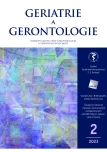Prevalence of frailty and risk factors of its development in the Czech population over 50 years of age – results of the SHARE study
Authors:
Vágnerová Tereza
Authors‘ workplace:
Geriatrická klinika 1. lékařské fakulty Univerzity Karlovy a Všeobecné fakultní nemocnice v Praze
Published in:
Geriatrie a Gerontologie 2023, 12, č. 2: 76-82
Category:
Original Article
Overview
Ageing is a persistent physiological process variable in its dynamics. It is a process that gradually and irreversibly leads to the development of one of the most important geriatric syndromes – frailty. The presence of chronic diseases or risk factors have the ability to significantly accelerate this development and thus exacerbate the functional deficit. In this article, we aimed to map the prevalence of frailty in the population over 50 years of age in the Czech Republic based on data from the SHARE project and to identify risk determinants that may negatively influence the development of frailty.
Keywords:
Primary care – geriatric frailty – risk factors
Sources
1. Romero-Ortuno R. The SHARE Frailty Instrument for primary care predicts mortality similarly to a frailty index based on comprehensive geriatric assessment. Geriatrics & gerontology international (online) 2013; 13(2): 497–504.
2. Romero-Ortuno R, Cathal D, Walsh BA, et al. A frailty instrument for primary care: findings from the Survey of Health, Ageing and Retirement in Europe (SHARE). BMC Geriatrics (online) 2010; 10(1): 57.
3. Woo J, Ruby YU, Wong M, et al. Frailty screening in the community using the FRAIL Scale. J Am Med Dir Assoc (online) 2015; 16(5): 412–419.
4. Cederholm TGL, Jensen MITD, Correia MC, et al. GLIM criteria for the diagnosis of malnutrition: A consensus report from the global clinical nutrition community. Clinical Nutrition (Edinburgh, Scotland) (online) 2019; 38(1): 1–9.
5. Romero-Ortuno R. The frailty instrument for primary care of the survey of health, ageing and retirement in Europe predicts mortality similarly to a frailty index based on comprehensive geriatric assessment. Geriatrics & Gerontology International (online) 2013; 13(2): 497–504.
6. Dent EJ, Morley AJ, Cruz-Jentoft H, et al. International Clinical Practice Guidelines for Sarcopenia (ICFSR): screening, diagnosis and management. J Nutr Health Aging (online) 2018; 22(10): 1148–1161.
7. Morley JE, Vellas B, Abellan G, et al. Frailty consensus: a call to action. J Am Med Dir Assoc (online). 2013, 14(6): 392–397.
8. Rockwood K, Song X, MacKnight Ch, et al. A global clinical measure of fitness and frailty in elderly people. CMAJ (online). 2005; 173(5): 489–495.
9. Ruiz J, Dent John E, Morley RA, et al. Screening for and managing the person with frailty in primary care: ICFSR Consensus Guidelines. J Nutr Health Aging (online) 2020; 24(9): 920–927.
10. Irving G, Neves AL, Dambha-Miller H, et al. International variations in primary care physician consultation time: a systematic review of 67 countries. BMJ Open (online) 2017; 7(10): e017902.
11. ÚZIS. Věkové složení obyvatelstva, 2021. Dostupné z: www. czso.cz/csu/czso/vekove-slozeni- -obyvatelstva-2021.
Labels
Geriatrics General practitioner for adults Orthopaedic prostheticsArticle was published in
Geriatrics and Gerontology

2023 Issue 2
Most read in this issue
- Presbyphagia versus dysphagia – the role of the speech therapist in the management of swallowing disorders
- Frailty – prevalence of acutely hospitalized seniors from 1995 to 2022
- Mental and physical condition of patients in postacute hospital care – analysis of the results of a Czech literature review
- Results of surgical treatment of proximal femur fractures in patients operated at the Traumatology Clinic of the University Hospital Olomouc in the years 2017–2021
